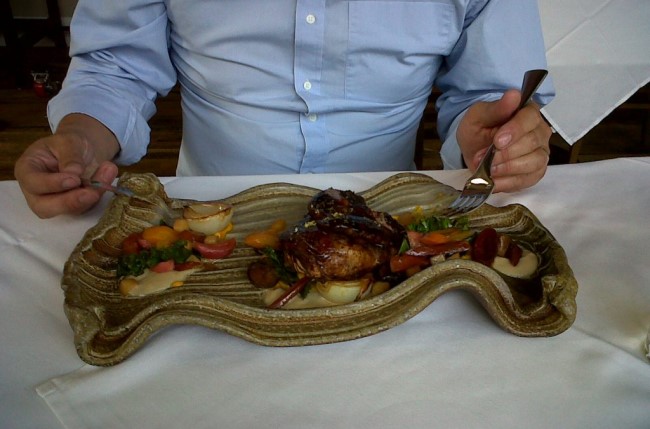
Guinea Fowl are one of the best additions to a homestead. They are great guard animals (my flock actually chased away a German shepherd once), they eat a ton of ticks each summer, and they are delicious. There are plenty of books and articles on how to raise Guineas, and I read many of them. There are a few things they missed. So I’ll just give you some of specific pointers based on my experience of raising two flocks. I raised them specifically for meat for the now-closed Grey Plume restaurant in Omaha, Nebraska.
1. Build a Tall, Large Coop:
Guineas like to nest in trees. If you try to raise them in a small chicken coop or close to the ground, they will escape and end up sleeping in your trees every night. And if your goal is to be able to process the birds for meat, you will never be able to catch them.
2. Don’t Coop them with Chickens:
The groups of birds will get along fine if you have them free-ranging a large acreage, but if you try to coop them together or keep them in a pen they will end up pecking each other and fighting. There may be exceptions – this is what I experienced.
3. Lock Them in the Coop Early in Life:
You’ll obviously start the chicks in a brooder, but once they are about two weeks old, move them to the coop. You can still bring in the heater and other baby-chick equipment, but you want to acclimate them to the coop as soon as possible. Once they are big enough to roam around outside, don’t let them right away. Keep them locked up until they are about 6-8 weeks old. This will train them to roost in the coop at night rather than opting for a tree. They will also know that the coop is a reliable source of food – but the truth is Guineas get most of their diet from foraging.
4. Let them Roam:
Guineas are very active. Once they are acclimated to a coop, they will return every night. I never even bothered locking our coop so they could get out at the crack of dawn. Let them hunt for ticks, explore your entire acreage, and POSSIBLY even in the garden. My guineas never touched my tomatoes or other produce, opting for bugs and pests instead. Other people have said they will eat produce, but I did not experience this.
5. Be Prepared for the Noise:
Guineas screech when provoked, scared, lost, and sometimes just for a group sing-a-long. At first their sound is scathing, like metal being ripped in two. It grows on you, though. Our guineas would gather on the deck at 4 p.m. each day just for a big screech-fest. I ended up loving the sound.
6. Gathering for Processing:
Acclimating them to the coop early on makes trapping the Guineas much easier. When it was time to go to the processer, we simply closed them in late one night after they’d all returned. Then, in the morning we were able to pick them out one-by-one from the coop and put into the cage for travel.
I am going to get another flock of Guineas soon, simply for the joy they bring to a farm. When we processed them for the Grey Plume, they were delicious. The chef used anise and root vegetables to create a delicious dish that sold out in one night. (And I got to taste the first one. I think its name was Snowball.)
Ben North lives and writes from a homestead in Iowa.

Larry Harness says
I live in central Missouri and I would love to Buy a number of these birds. Do you have any Do you have any idea where I might be able to buy them in central Missouri . Thank you, Larry
Joan says
https://www.cacklehatchery.com/product-category/guinea-peafowl/guinea-fowl/
Steve Martin says
My grandparents had 20 or so guinea during my whole childhood. One hundred acres. They had no enclosure and appeared to be just fine. Great security and their eggs are hard as steel shot. Had many a meal when cooked up like fried chicken. Lots of fond memories of them and the farm.